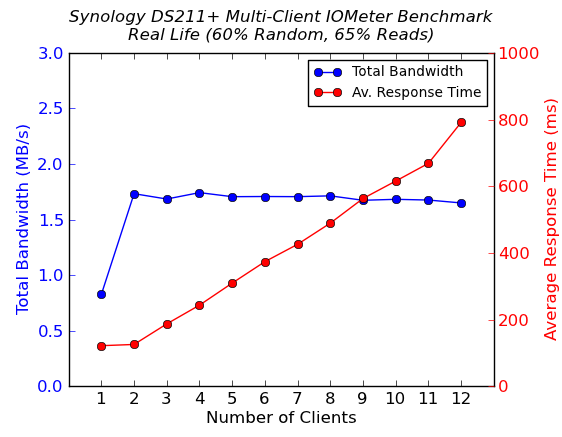Building the 2012 AnandTech SMB / SOHO NAS Testbed
by Ganesh T S on September 5, 2012 6:00 PM EST- Posted in
- IT Computing
- Storage
- NAS
Testbed in Action : Synology DS211+
One of the first NAS units that we put through our new test suite was the Synology DS211+. The following four graphs show the total available bandwidth and the average response time while being subject to different types of workloads through IOMeter. IOMeter also reports various other metrics of interest such as maximum response time, read and write IOPS, separate read and write bandwidth figures, etc. Selected metrics from the evaluation of the Synology DS211+ are available here. The values corresponding to the points plotted below can also be seen in the above link.




The first graph shows that the DS211+ is able to hit as high as 112.65 MBps in 100% sequential reads when five clients are simultaneously accessing the unit. However, for more than 7 clients, the total available bandwidth sees a decrease. In all the four cases, the average response time seems to increase only linearly. However, a look at the maximum response time in the above link shows that under some conditions, clients need to wait for as much as 10 seconds for a transaction to complete.
The Synology DS211+ seems to be a good fit for cases where there are 5 - 10 computers simultaneously accessing the unit, but performance seems to degrade with additional users.










74 Comments
View All Comments
ganeshts - Thursday, September 6, 2012 - link
Thanks for unearthing that one.. Fixed now.ypsylon - Thursday, September 6, 2012 - link
14 SSDs. I know it is only to simulate separate clients, but to be honest this whole test is ultimately meaningless. No reasonable business (not talking about 'man with a laptop' kind of company) will entrust crucial data to SSD(s) (in particular non-industry class standard SSDs). Those disks are far too unreliable and HDDs trounce them in that category every time. Whether you like it or not, HDDs are still here and I'm absolutely certain that they will outlive SSDs by a fair margin. Running a business myself and thank you very much HDDs are the only choice, RAID 10, 6 or 60 depending on a job. Bloody SDDs, hate those to the core (tested). Good for laptops or for geeks who benching system 24/7 not for serious job.ypsylon - Thursday, September 6, 2012 - link
Dang 12 not 14 , ha, ha.mtoma - Thursday, September 6, 2012 - link
If you love so much the reliability of HDDs, I must ask you: what SSD brand have failed you? Intel? Samsung? You know, they are statistics that show Intel and Samsung SSD are much more reliable 24/7 than many Enterprise HDDs. I mean, on paper, the enterprise HDDs looks great, but in reality they fail more than they should (in a large RAID array vibration is a maine concern). After all, the same basic technology applies to regular HDDs. On top of that, some (if not all) server manufacturers put refurbished HDDs in new servers (I have seen IBM doing that and I was terrified). Perhaps this is not a widespread practice, but it is truly terrifying.So, pardon me if I say: to hell with regular HDDs. Buy enterprise grade SSDs, you get the same 5 year warranty.
extide - Thursday, September 6, 2012 - link
Dude you missed the point ENTIRELY, the machine they built is to TEST NAS's. They DID NOT BUILD A NAS.Wardrop - Saturday, September 8, 2012 - link
I can't work out whether this guy is trolling or not? A very provocative post without really any detail.AmdInside - Thursday, September 6, 2012 - link
Isn't Win7 x64 Ultimate a little too much for a VM? Would be nice to see videos.ganeshts - Thursday, September 6, 2012 - link
We wanted an OS which would support both IOMeter and Intel NASPT. Yes, we could have gone with Windows XP, but the Win 7 installer USB drives were on the top of the heap :)AmdInside - Thursday, September 6, 2012 - link
Thankszzing123 - Thursday, September 6, 2012 - link
Hi Ganesh - Thanks for taking my post a few articles back to heart regarding the NAS performance when fully loaded, as it begins to provide some really meaningful results.I have to agree with some of the other posters' comments about the workload though. Playing a movie on one, copying on another, running a VM from a third and working of docs through an SMB share on a fourth would probably be a more meaninful workload in a prosumer's home.
In light of this, might it be an idea to add a new benchmark to AnandTech's Storage Bench that measures all these factors?
In terms of your setup, there's a balance to be struck. I really like the concept you're doing of using 12 VM's to replicate a realistic environment in the way you can do. However when an office has 12 clients, they're probably using a proper file server or multiple NAS's. 3-4 clients is probably the most typical set up in a SOHO/home setup.
10GbE testing is missing, and a lot of NAS's are beginning to ship with 10GbE. With switches like the Cisco SG500X-24 also supporting 10GbE and becoming slowly more affordable, 10GbE is slowly but surely becoming more relevant. 1 SSD and 1 GbE connection isn't going to saturate it - 10 will, and is certainly meaninful in a multi-user context, but this is AnandTech. What about absolute performance?
How about adding a 13th VM that leashes together all the 12 SSD's and aggregates all the 12 I340 links to provide a beast of RAIDed SSD's and 12GbE connectivity (the 2 extra connections should smoke out net adapters that aren't performing to spec as well).